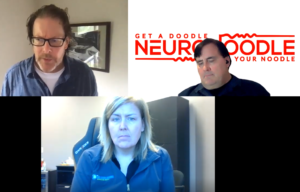Neuropsychologists Dr. Laura Jansons and Dr. Skip Hrin discuss Panic Attacks, Anxiety. using an EEG to detect as well as Neurofeedback to treat
Click HERE for Podcast
Please give us 5 stars on Apple Podcast !!
Researcher Proposes New Theory of Consciousness
Electromagnetic energy in the brain enables brain matter to create our consciousness and our ability to be aware and think, according to a new theory developed by Professor Johnjoe McFadden from the University of Surrey.
the brain’s information-rich electromagnetic field is in fact itself the seat of consciousness, driving ‘free will’ and voluntary actions.
consciousness is the experience of nerves plugging into the brain’s self-generated electromagnetic field to drive what we call ‘free will’ and our voluntary actions.”
the information integration is implemented in time, rather than space, and thereby cannot correspond to physically integrated information
The cemi field theory proposes a scientific dualism that is rooted in the difference between matter and energy, rather than matter and spirit.
Dr. Skip Article
Conservative and liberal attitudes drive polarized neural responses to political content
Significance
Partisan biases in processing political information contribute to rising divisions in society. How do such biases arise in the brain? We measured the neural activity of participants watching videos related to immigration policy. Despite watching the same videos, conservative and liberal participants exhibited divergent neural responses. This “neural polarization” between groups occurred in a brain area associated with the interpretation of narrative content and intensified in response to language associated with risk, emotion, and morality. Furthermore, polarized neural responses predicted attitude change in response to the videos. These findings suggest that biased processing in the brain drives divergent interpretations of political information and subsequent attitude polarization.
Abstract
People tend to interpret political information in a manner that confirms their prior beliefs, a cognitive bias that contributes to rising political polarization. In this study, we combined functional magnetic resonance imaging with semantic content analyses to investigate the neural mechanisms that underlie the biased processing of real-world political content. We scanned American participants with conservative-leaning or liberal-leaning immigration attitudes while they watched news clips, campaign ads, and public speeches related to immigration policy. We searched for evidence of “neural polarization”: activity in the brain that diverges between people who hold liberal versus conservative political attitudes. Neural polarization was observed in the dorsomedial prefrontal cortex (DMPFC), a brain region associated with the interpretation of narrative content. Neural polarization in the DMPFC intensified during moments in the videos that included risk-related and moral-emotional language, highlighting content features most likely to drive divergent interpretations between conservatives and liberals. Finally, participants whose DMPFC activity closely matched that of the average conservative or the average liberal participant were more likely to change their attitudes in the direction of that group’s position. Our work introduces a multimethod approach to study the neural basis of political cognition in naturalistic settings. Using this approach, we characterize how political attitudes biased information processing in the brain, the language most likely to drive polarized neural responses, and the consequences of biased processing for attitude change. Together, these results shed light on the psychological and neural underpinnings of how identical information is interpreted differently by conservatives and liberals.




